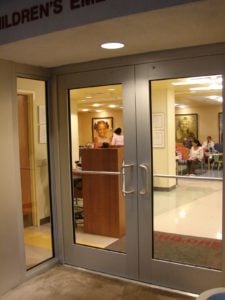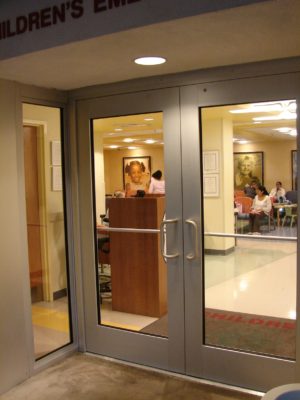The 2015 Guidelines for Preventing Workplace Violence for Healthcare and Social Service Workers issued by the Occupational Safety and Health Administration (OSHA) note that “Healthcare and social service workers face a significant risk of job-related violence.” According to OSHA, about 10% of all workplace injuries are assaults—and roughly 75% of all workplace assaults are suffered by healthcare workers. One quarter of healthcare-related on-the-job deaths are the result of such assaults. Patient-inflicted injuries account for roughly 30% of the money hospitals spend each year on worker’s compensation lawsuits and injury-related sick days. All told, healthcare systems lose roughly $2 billion each year in workman’s comp claims, and spend an average of $75,000 to replace each nurse who gets fed up and quits. It’s a frightening and expensive problem for all involved.
Good Barriers Increase Hospital Safety
Fortunately, we know that effective security barrier systems can make a substantial dent in this violence. A 2008 study published in the Annals of Epidemiology found that increasing hospital security decreased assault rates by 48%. The Emergency Nurses Association’s 2011 Emergency Department Violence Surveillance Study also founded that “the presence of an enclosed nurses’ station” correlated to significant reductions in verbal assault against staff (basically halving such incidents).
 OSHA currently recommends that institutional hospitals consider bullet resistant barriers for reception areas and anywhere money changes hands with the public. Since 2002 NIOSH (the National Institute for Occupational Safety and Health, a division of the Centers for Disease Control) has likewise recommended healthcare systems “install deep service counters or bullet-resistant and shatterproof glass enclosures in reception areas.” California’s Division of Occupational Safety and Health issued similar guidelines as far back as 1998: “Bullet resistant glass should be used to provide protection for triage, admitting or other reception areas where employees may greet or interact with the public.” Rosen’s Emergency Medicine: Concepts and Clinical Practice has an entire section dedicated to “Preparing the Emergency Department to Prevent Violence.” Their key takeaway is that access control and strategic use of bullet resistant barriers can be extremely effective:
OSHA currently recommends that institutional hospitals consider bullet resistant barriers for reception areas and anywhere money changes hands with the public. Since 2002 NIOSH (the National Institute for Occupational Safety and Health, a division of the Centers for Disease Control) has likewise recommended healthcare systems “install deep service counters or bullet-resistant and shatterproof glass enclosures in reception areas.” California’s Division of Occupational Safety and Health issued similar guidelines as far back as 1998: “Bullet resistant glass should be used to provide protection for triage, admitting or other reception areas where employees may greet or interact with the public.” Rosen’s Emergency Medicine: Concepts and Clinical Practice has an entire section dedicated to “Preparing the Emergency Department to Prevent Violence.” Their key takeaway is that access control and strategic use of bullet resistant barriers can be extremely effective:
“Controlling flow through the ED [emergency department] can be an effective method of preventing violent acts. High risk departments should limit access to one or two entrances, especially during the evening hours. Bulletproof glass barriers and buzzer access systems are useful as well. … One large urban county hospital with a high incidence of violent behavior in the ED is equipped with a large security force, metal detectors, a bulletproof Plexiglas triage area, a keypad security entry, controlled entryway into the ED, and metal bars to prohibit cars from driving into the department. The hospital reports no incident of weapons-related violence or injury in the ED since these measures have been implemented.”
Helping Healthcare Facilities Craft Good Bullet Resistant Security
But not all bullet proofing companies are prepared to design and install ballistic barrier systems in healthcare facilities. As Total Security Solutions CEO Jim Richards explains, “This can be really tricky, because of the many use cases you can see in a single hospital or healthcare building. We’re especially sensitive to how a security barrier system has to be ‘barrier-free’, complying with ADA expectations, local fire codes, NFPA Life Safety Code, all of that—all while keeping doctors and nurses safe without hindering them in their work.”
In Jim’s experience hospitals have three security zones, each with different needs: The pharmacy, reception, and the security screening area.
- Pharmacy Bullet Resistant Barriers: This is an often neglected portion of the hospital, despite the combined risk factors: The pharmacist handles cash, dispenses valuable narcotics, and is often located very close to an exit. Pharmacy barriers generally can be well served by a simple all-in-one transaction window and counter with integrated deal tray, but often also need a custom package passer or rotary susan, so that they can securely and easily dispense larger items.
- Reception Area Bullet Resistant Barriers: Most reception areas will have a long counter with several triage stations. This can be well served by a single sheet of bullet resistant acrylic with voice ports. Such an approach allows for both clear communication and good sight lines. Simple deal trays are usually sufficient for passing paperwork, with perhaps a single secure drawer serving the entire counter. Don’t forget to reinforce the counter itself with bullet resistant fiberglass.
- Security Screening Area Resistant Barriers: Many larger urban healthcare facilities are integrating small police outposts and formal security screening areas near their emergency departments. These areas are usually best served by configurations a bit more like an airport security checkpoint than a traditional retail or municipal security barrier. Electronically controlled bullet resistant doors with large ballistic windows are standard, as are transaction windows with integrated communication and package passers.
Ballistic Security for Cannabis Dispensaries and Pain Clinics
These stand-alone services are still finding their place in the healthcare industry—and often face unique economic, security, and regulatory challenges. Total Security Solutions is attuned to these unique challenges, and can offer simple, affordable bullet resistant systems to fit any space, configuration, and style of operation.
- Sign up for our newsletter to stay up-to-date with the latest industry news
- Follow us on Twitter, Facebook or LinkedIn
- Download our Ultimate Guide to Bulletproof Glass and Bullet Resistant Barriers infographic


